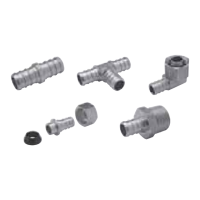ZURN PEX® RESIDENTIAL FIRE PROTECTION SYSTEMS
INSTALLATION INSTRUCTIONS
9
IMPORTANT: When running Zurn PEX tubing, be sure to keep it away from potential sources of heat. Maintain a minimum of 12" between Zurn PEX and any recessed
light fixture and a minimum of 6" between Zurn PEX and any gas appliance vent.
The use of zip ties to attach Zurn PEX to DWV piping is acceptable so long as the ties leave enough room for free movement of the tubing.
NOTE: When installing runs of Zurn PEX, it is sometimes necessary to pull one tube past another. Care should be taken to make sure that the friction of the moving tube
does not burn or wear a notch in the stationary tube. If this occurs, the notched section of the tube must be cut out and replaced.
TUBING EXPANSION
Zurn PEX tubing should not be pulled tight during installation.
Adequate slack should be determined in order to prevent
the tubing from exerting tensile loads on the connections
to the fittings.
Allow 1/8" per foot of tube length as slack. This should cover
installations from 35°F to 160°F.
BENDING ZURN PEX TUBING
The minimum bend radius for Zurn PEX is 6 times the outside
diameter of the tubing, when bending it with the natural curvature
of the coil.
Note: If you must bend against the natural curvature of the coil,
these minimums must be multiplied by 3.
METAL STUDS
Protective sleeves or bushings should be used on Zurn PEX tubing
when penetrating metal studs. Sleeves and bushings are not
required when penetrating ordinary wood or particle board if the
holes are at least 1/8" larger than the tube size and tube movement
is not restricted.
INSULATING TUBING
Zurn PEX is resistant to freeze damage; however, installation
specific variables can aect the performance of the system if it
is allowed to freeze up. In general, plumbing codes specify that
tubing run through attics and exterior walls should be insulated.
As such, Zurn PEX tubing should be insulated according to code
requirements. Insulation that is typically used in copper and
CPVC installations would provide equivalent protection for
Zurn PEX tubing.
Note: When using expanding foam to insulate tubing, please
contact Zurn for recommendations. While many expanding foams
have been tested and have shown no adverse eects to PEX
tubing, we cannot guarantee all foams are the same.
NAILING PLATES
Nailing plates should be used when Zurn PEX tubing is passing
through a stud within 2" of a nailing surface. Using a nailing plate
minimizes the possibility of damage to the tube from nails or
drywall screws.
Note: Best results are achieved by using clamps, pipe insulators,
and strapping designed for plastic plumbing systems.
TUBING SIZE OUTER DIAMETER MINIMUM BEND RADIUS
3/8" .500" 3.00"
1/2" .625" 3.75"
3/4" .875" 5.25"
1" 1.125" 6.75"
1-1/4" 1.375" 8.25"
1-1/2" 1.625" 9.75"
2" 2.125" 12.75"
Wall Stud

